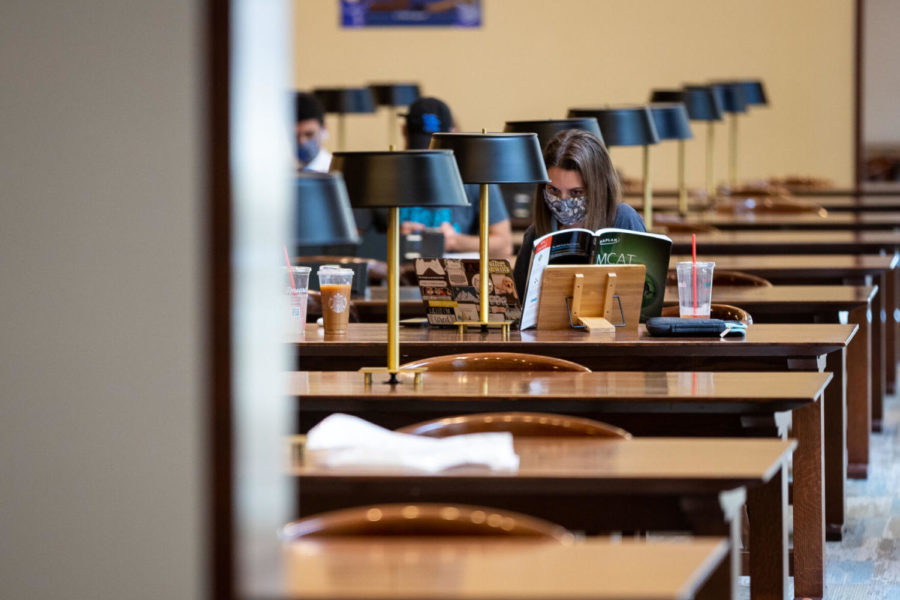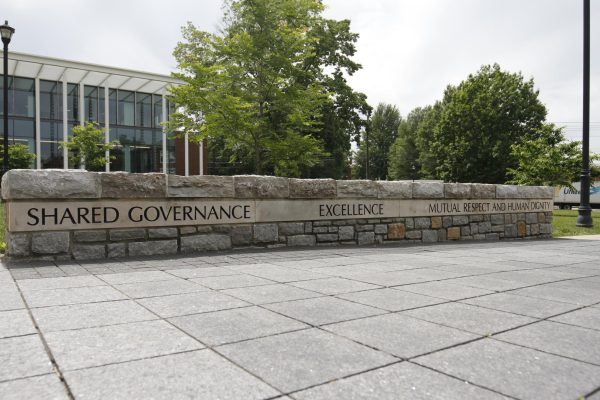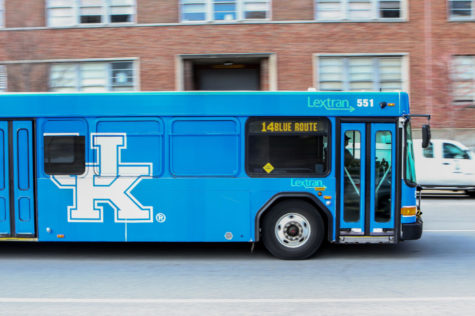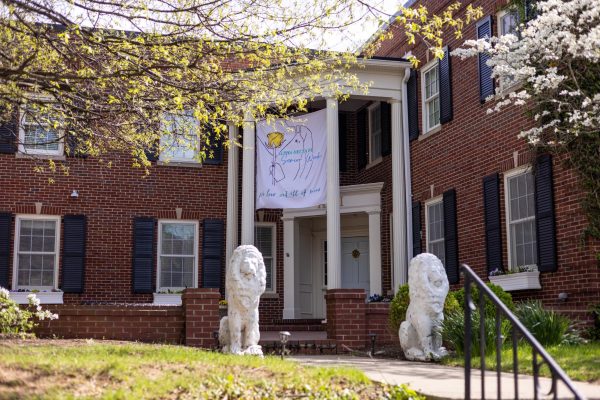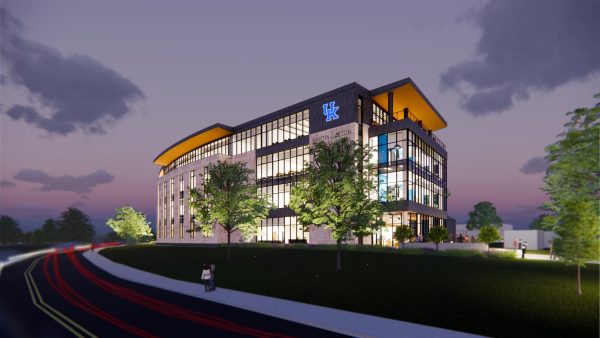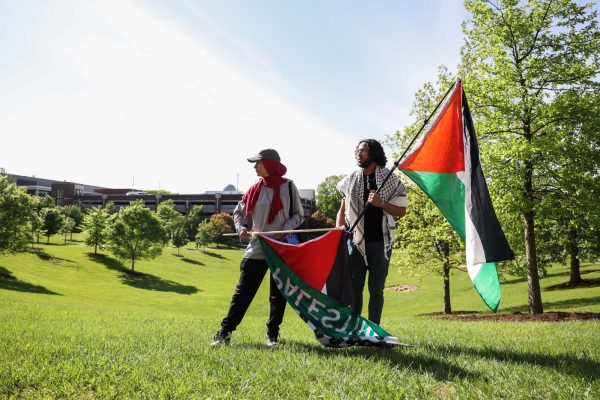Academic adaptations extend beyond classroom during COVID-19
April 6, 2021
As UK closes out its third semester during the COVID-19 pandemic, remote learning has come to encompass more than just online class. A student success workstream, which managed UK’s switch to remote learning, was one of the first initiatives begun last March by Provost David Blackwell; a year later, the campus itself reflects many changes to the way students live and learn.
In January, UK launched the Flex Desk program, which provides students with open study spaces in multiple buildings around campus. Rom hours vary based on when a specific building closes, but most are available Monday through Friday from 8:00 a.m. to 5:00 p.m.
Kathy Hamperian, UK’s Executive Director of Customer Support and IT Enablement, managed the project. She works with ITS Customer Services, connecting students to technology help and student labs.
“Being in the dual modality…we have students who are taking classes in person [that] may immediately be followed by a class online,” Hamperian said. “We heard from the Student Success folks that most students had both types of classes in a single day. […] We were asked to try to find space so students could go and…do their online classes right after or right before their in-person class.”
The Flex Desk program was inspired by campus canopies, a series of tents that UK put up across campus in the fall to give students more opportunities to socialize while distancing.
“We all knew it was going to be a little too cold to be going out in the tents,” Hamperian said. “We knew they were used…[and] we knew we would still be doing dual modality in the spring.”
Hamperian collaborated with multiple offices to find rooms that were not scheduled for classes in various locations around campus. The team also worked to get the word out about the program, including putting a map of Flex Desk locations on the UK: Go app.
“We knew that students were looking for this…so we didn’t really have any challenges working together as a group,” Hamperian said. “Everybody just worked so well together.”
“[We] came together to try to use all the different resources and networks that we had to…make it possible,” said Marianne Young, Assistant Provost for Student and Academic Support. “We have students that are taking classes in a variety of locations across campus, and so being able to identify a building on the north side of campus or more towards the medical side of campus has been…very helpful.”
Young explained that Student Success’s main priority has been transitioning their advising services—including CARES, career support and resources for first-generation students—to offer both in-person and virtual access. She pointed to UK’s Learn Anywhere site as a good point of access for remote learning resources.
“That Learn Anywhere site really became a one-stop shop in terms of helping students figure out how [to] engage with the services that are here to support [them],” Young said. “[We] really tried to make those support services accessible and easy to find for students as we’re navigating a new environment that we’ve never been in before.”
Though data on students’ usage of Flex Desk spaces has not been gathered, students who do use them appreciate them. Raegan Persful, a freshman studying public health and epidemiology, frequently visits the Flex Desk space in the 90 with her friends.
“I would love to be at the library, but it’s just hard,” she said. “Some days they allow everyone to move the chairs around and you can have 10 people at a table, and then the next day we come around and…they make you move on the other side of the room, so the inconsistency is hard to plan out if you want to be with people to do work.”
Sophomore Chase Worthington, who studies finance and accounting, also utilizes the Flex Desk space in the 90.
“Usually, I do work [here] because I’m stressed,” he said. “I work on management, economics and accounting—pretty much all my classes.”
However, Student Success and Information Technology Services are not the only departments working to improve remote learning.
“Every department [and] college has done something to try to make things easier because this cannot be easy for students,” Hamperian said. “This is not a typical college experience, so we had to all be pretty flexible.”
One example of this is The Study, UK’s on-campus tutoring center, which rapidly transitioned from in-person tutoring to virtual tutoring in March 2020.
“We always had plans to expand to offer virtual [tutoring]; we just had to really accelerate that timeline to pilot something,” said Christie Maier, assistant director for peer tutoring at The Study. “We love to test something small and then learn and grow from that; this very much was ‘we’re doing it now,’ so we learned a lot very quickly.”
As UK’s campus reopened, The Study began offering in-person tutoring again; however, its operation still had to change to abide by physical distancing guidelines.
“Physically being apart from the student you’re working with [has] some challenges,” Maier said. “It’s very natural for [tutors] to look over [a student’s] shoulder at their computer. It’s really natural to be looking and working on the same document or piece of paper.”
Even with virtual offerings, The Study has seen a drop in the number of students seeking tutoring.
“We used to see 500 to 700 sessions a week…and that’s just not what students are doing right now,” Maier said. “Moving into fall semester, where we will hopefully have a much more traditional residential experience [is] going to be a huge emphasis to us.”
Specific colleges have also been developing their own remote learning opportunities. Dr. Lisa Blue, a lecturer in the College of Arts and Sciences’ Department of Chemistry, transitioned the General Chemistry and Organic Chemistry Learning Centers online over a period of 10 days. She initially held open Zoom office hours, but she now uses Tutor Matching Service to partner students with private tutors.
“I took it from just a little table in the back of a computer lab to an actual full-fledged learning center that has since been duplicated across campus,” Blue said. “I used to drop into the learning centers [to] see how everything was going [and] make sure the TAs had the resources they needed. […] I liked students knowing that we had them covered.”
Student advising has also seen a shift in atmosphere in moving to online, though the changes are not all detrimental. Many of these resources will continue their virtual offerings when UK returns to normal operations in the fall of 2021.
UK President Eli Capilouto announced in the beginning of March that UK will return to in-person classes in “similar numbers to that of fall 2019.” Outside of class schedules, places like The Study will continue virtual tutoring.
“Even before COVID-19 hit, we had intentions of bringing on a virtual option,” Maier said. “There are students [where] it is challenging for them to access tutoring in person, whether…they live off campus [or] they don’t have a parking pass; that inherently can be a barrier for some students.”
The General Chemistry Learning Center will offer online tutoring through the summer, after which the department will “figure out which modes of communication will best address the needs of…freshman and sophomore students,” according to Blue.
“My hope is to go back to face-to-face because I think we have a lot more casual interactions,” Blue said. “Students need a place to hang out in between classes.”
Other faculty members have encountered similar challenges connecting with students and promoting their remote learning programs. Blue said that traffic for the chemistry learning centers is “way down” as well.
“We’ve tried really hard to be consistent with messaging, but I think with all of the classes being online…that messaging has gotten drowned out in all the emails that students get,” Blue said. “It was nice to be able to stand in front of my classes and say, ‘Hey, if you need help with your classes, our learning centers are open.’”
Overall, UK faculty hope to maintain a connection with students, no matter what modality they use to offer their services.
“We may not be immediately visible because students aren’t walking through the building, but we’re still here,” Blue said. “We’re still rooting for their success, and we still want to support them in any way possible.”









































































































































